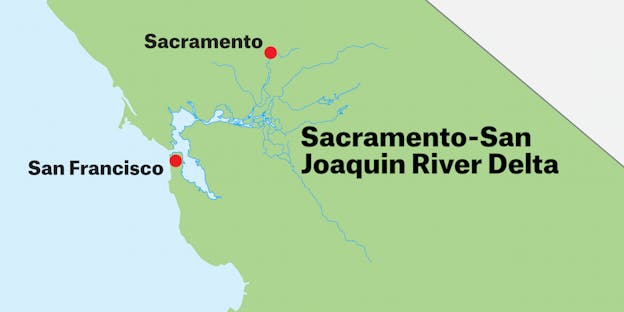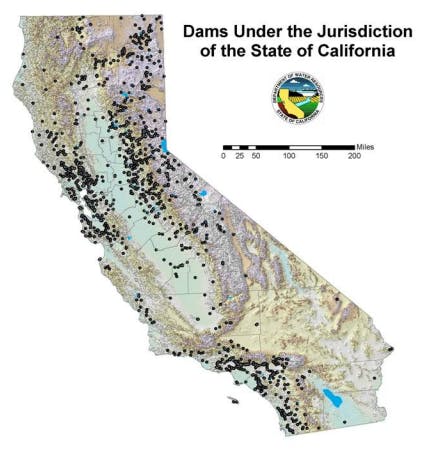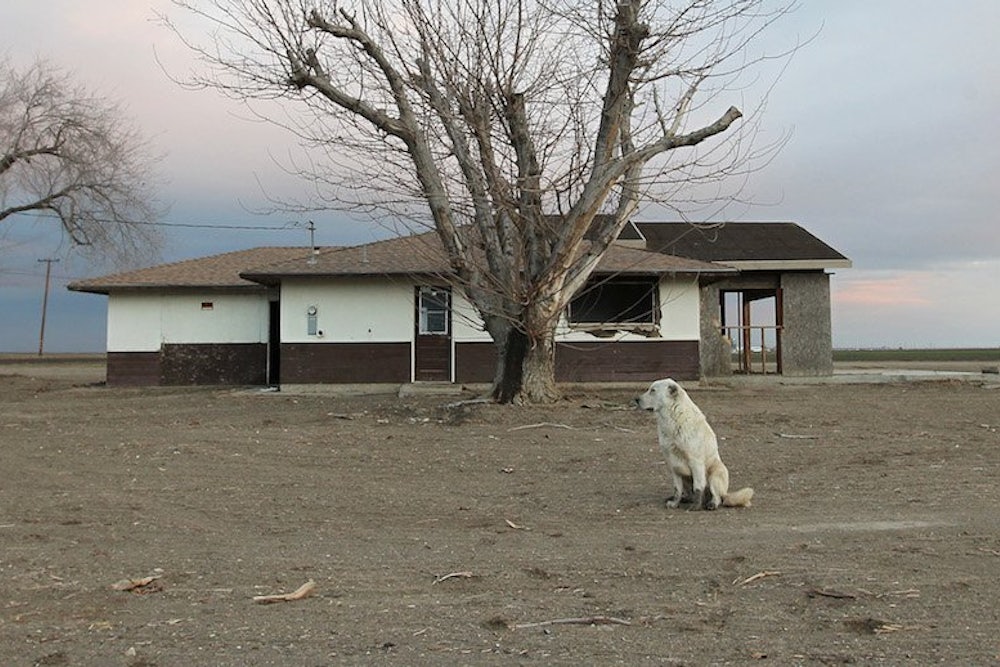California's Central Valley—one of the nation’s densest agricultural areas— is so parched that many roads and bridges have begun to buckle for lack of water underground to hold the land in place. Farmers have uprooted trees to conserve water for other crops. Private wells that supply drinking water to poor neighborhoods, like those in East Porterville, have run dry, forcing residents to rely on donated bottled water.
To explain this slow-motion catastrophe, conservatives don’t acknowledge the obvious—the historically low snowpack from the Sierra Nevada Mountains, which flows into the state's second-largest river, the San Joaquin—to explain Californians' troubles. Rather, they blame a three-inch-long endangered fish called the delta smelt. Or, more to the point, they blame environmentalists’ silly, civilization-destroying causes, such as trying to prevent extinctions and staving off the collapse of ecosystems.
Fox News, National Review, American Thinker, Town Hall, Breitbart, and Reason have all suggested that environmental policies have exacerbated the perilous lack of water in California, and that liberals are trying to hide it by shifting blame to agriculture. Carly Fiorina, a possible 2016 GOP presidential candidate, charged that the drought is a “man-made human tragedy” brought on by “overzealous environmentalists.” A recent Wall Street Journal editorial argued, “The liberals who run California have long purported that their green policies are a free (organic) lunch, but the bills are coming due.” The WSJ blames drained reservoirs and aquifers on resource misallocation, not necessarily the low snowpack.
Here's how the fiscal conservatives would address this “manmade drought”: Build more water storage and infrastructure, from aqueducts to dams, to drain more runoff from rivers before it flushes into the ocean (these don't come cheap; one proposed project to build two 35-mile tunnels from Sacramento River would cost $25 billion). But first, they would need to roll back environmental regulations that prevent more water from being diverted for human activities, instead of leaving the water to nourish a once-rich ecosystem that’s deeply threatened. They are so dogmatically opposed to environmental regulations of any sort that they've seized on this protected fish and California's terrifying drought in their wider campaign to undermine the legislative successes of the environmental movement. One of the laws under attack: the decades-old Endangered Species Act, which regulators used to label the delta smelt as “threatened” in 1993.
If Republicans get their way, they'd undertake a grossly short-sighted approach—effectively sacrificing more animals and more habitat to buy a few moments more of unfettered water use—until Californians won't be able to undo the permanent damage to the region.

The Sacramento-San Joaquin Delta—where two of California's largest rivers join together— is home to the state’s largest habitat for fish and wildlife, most of which is uniquely adapted to the brackish channels. Saltwater from the ocean intrudes into the delta, but generally there's enough freshwater to keep it largely made up of freshwater. Because the delta smelt breed in freshwater, their health indicates how other wildlife, including salmon, are doing. The answer right now is, the smelt are not well. In a state survey that usually turns up at least dozens of the fish, researchers found but a single, lonely smelt.
And yes, as conservatives argue, the Delta serves a critical function for the rest of California—water that flows there from the north supports two-thirds of southern and central California. Conservatives’ spin conceals the fact that water left to replenish the environment is really doing double, even triple duty for human benefit. It’s not wasted, nor is it simply flushed out to the ocean, as many articles have stated.
Beyond ensuring a diverse ecosystem, it supports fisheries; California chinook salmon fishermen generated nearly $23 million in 2013. It ensures safe water quality for human use; the freshwater keeps salt water at bay by forming a barrier that prevents the powerful pumps for state and federal projects from sucking seawater to redirect to the rest of the state. By diverting so much of the river upstream of the delta, the water downstream “can become so salty that the water from the export pumps would need expensive treatment (desalination) to be used for drinking or growing crops,” Natural Resources Defense Council senior attorney Doug Obegi said. Twice last year, officials warned that too much seawater might invade the delta.

Besides the benefits of keeping water flowing, there’s the practical question of where, in this supposed fix, conservatives would put more water storage. “We’ve built on all the dam sites,” Pacific Institute’s Peter Gleick said. “Even if we built a couple of dams, we don’t have water to fill them. We’re tapped out. The traditional answer of building more reservoirs won’t solve our problems.” Building additional reservoirs does little when there's no snow or rain to fill them. California has more than 1,400 dams and has added 8.6 million acre-feet of water storage since 1969.
The idea of an environmentalist-created drought isn’t Fiorina’s invention, nor is it a new talking point. It has existed in some form or another since at least 1991, when Congress passed the Central Valley Improvement Act. That law mandated a minimum amount of water to flow to the Sacramento-San Joaquin Delta. The only thing the drought has done is “raise the volume of protests,” Gleick said.
The amended 1973 Endangered Species Act gave environmentalists their legal tools to fight overuse of water, helping them block subsidies for new dams, which block salmon migration, and reservoirs, which drain water from their environment. House Republicans have tried at least three times in three years to divert resources away from the U.S. Fish and Wildlife Service, the agency responsible for protecting the smelt. Ideally, conservatives hope to suspend entire portions of the popular act to pump water to farms without restriction.
Congressional attempts to roll back environmental legislation are unlikely to make it past President Barack Obama’s desk, no matter how often they try. Even so, the environment is already taking a backseat to other priorities in thirsty California. In normal years, half of the water is left to replenish the environment—the rest goes to agriculture industry and cities. Except these are not normal years, and less water than ever is left to the environment. The State Water Control Board has already waived wildlife standards to allow more than 1.2 million acre-feet meant for the environment to go to agriculture and urban uses. In the middle of the drought, the board dispensed five times as much water rights as it had water. On top of that, more water is disappearing from the delta than should be, leaving officials to wonder whether farmers are taking more than their legal share.
Americans have built up a massive water infrastructure by looking at supply—how to move water from wet regions to dry by building dams and aqueducts to divert water for human consumption. In California’s case, that has meant building more than 1,400 dams to steer the water melting out of the Sierra Nevada mountains. To Democrats, environmentalists, and water policy experts, the drought has forced a hard reckoning with this approach, as California's agriculture and residential sectors increasingly look at ways to reduce demand—by recycling water, replacing thirsty lawns with drought-friendly landscapes, and using water-efficient crops and irrigation. Meanwhile Republicans advocate building more empty water storage.
At times environmentalists haven’t been so reliable. They’ve blamed the 70 million gallons of water used for fracking and the bottled water industry for wasting water, when both count for a miniscule amount, obscuring the actual impact by talking about “millions of gallons” of water use. (One acre-foot is equal to 325,851 gallons.) In fact, the impressive 70 million gallons of water used for fracking converts to just 214 acre-feet, a proverbial drop when compared to 34 million acre-feet used in agriculture. “When someone talks about millions of gallons, it's because they don’t want to talk about hundreds of acre-feet,” Obegi said.
The reality is human activities of all types have cost California. The state has never had a water policy befitting its limited supply. You can see that in the agriculture sector, which drinks 80 percent of the water California dedicates to human use. Farmers who were there first can tap a plentiful, cheap supply, forcing only newer-comers to be economical. Urban use is responsible for the other 20 percent of human water use.
Climate change will only add to these woes in the West. By mid-century, the current four-year drought will seem inconsequential compared to California’s expected 30-year megadroughts, a genuinely manmade disaster. If we continue in the coming years to use water irresponsibly and pollute indefinitely, soon enough we won’t have any fish left to blame.
